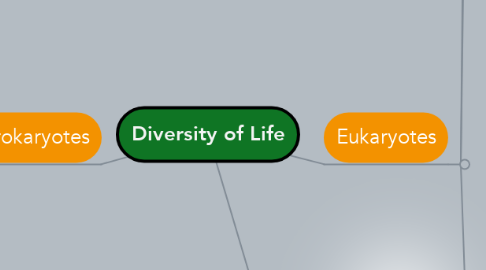
1. Prokaryotes
1.1. Archaelbacteria
1.1.1. inhabit some of the most extreme environments on the planet
1.1.1.1. places that have high salt concentration
1.1.2. Characteristics
1.1.2.1. does not have oxeygen
1.1.3. methane, halophiles
1.2. Eubacteria
1.2.1. charateristics
1.2.1.1. unicellular, lack cell membrane and mitochondira
1.2.2. cocci, spirillia, bacilli
1.3. Reproduction
1.3.1. produce 2 identical cells
1.3.2. reproduction is quick
1.3.3. Transformation
1.3.3.1. Genetic information from another source is taken up in to another bacteria cell
1.3.4. Conjusction
1.3.4.1. a plasmid copies its material into another cell
1.3.5. Transduction
1.3.5.1. A virus transfers new material
1.4. Protista
1.4.1. Charateristics
1.4.1.1. All protists are aquatic
1.4.1.2. very diverse
1.4.1.3. Heterotrophic OR Autotrophic
1.4.1.4. motile
1.4.1.5. unicellular
1.4.1.5.1. some are multicellular
1.4.1.6. Large complex cells with many organelles
1.4.2. Species
1.4.2.1. Sarcodines
1.4.2.1.1. Ameoba species
1.4.2.1.2. fresh water and salt water
1.4.2.1.3. reproduction sexual and asexual
1.4.2.1.4. characterized by pseudopods
1.4.2.2. Zooflagellates
1.4.2.2.1. Trypanosoma gambiense
1.4.2.2.2. water or within another organism
1.4.2.2.3. move by thier flagella
1.4.2.3. Ciliates
1.4.2.3.1. Paramecium caudatum
1.4.2.3.2. fresh water and salt water
1.4.2.3.3. characterized by having tiny hair like projections that beat like oars of a boat to move
1.4.2.4. Plasmodium
1.4.2.4.1. lives in the gut of a female mosquito and bloodstream of certain animals
1.4.3. Plant like Protista
1.4.3.1. Euglenoids
1.4.3.1.1. Euglena
1.4.3.1.2. Green Algae
1.4.4. Fungus like protist
2. have a 2 segmented body, 8 legs with no antennae or wings
3. Eukaryotes
3.1. Fungi
3.1.1. Characteristics
3.1.1.1. 2 main parts
3.1.1.1.1. mycelium
3.1.1.1.2. fruiting body
3.1.1.2. cel walls made of chitin
3.1.2. reproduction
3.1.2.1. Hyphae breaks off and releases spores
3.1.2.2. sexual
3.1.2.2.1. 2 different sexes
3.1.2.2.2. diploid zygospores
3.1.2.2.3. joining of two genetically different hyphae produce dikaryotic hyphae
3.1.3. 4 sub phyla
3.1.3.1. Ascomycota
3.1.3.1.1. sacs that contani sexual spores
3.1.3.2. Chytridomycota
3.1.3.2.1. fungi that have flagellated spres
3.1.3.3. Zygomycota
3.1.3.3.1. sexual spores
3.1.3.4. basidiomycota
3.1.3.4.1. club shaped
3.1.3.4.2. contain sexual spores
3.1.3.4.3. mushrooms, shelf fungus
3.2. Plantea
3.2.1. 12 different plylum
3.2.1.1. Nontracheophytes phylums
3.2.1.1.1. mosses, liverworts
3.2.1.1.2. Characteristics
3.2.1.1.3. 3 phylas
3.2.1.2. Tracheophytes phylums
3.2.1.2.1. Angiosperm group
3.2.1.2.2. Gymnosperm group
3.2.1.2.3. Trachophytes revolutionized the pathway for long distance transport of water
3.2.2. Charcteristics
3.2.2.1. multicelluar
3.2.2.2. Photosynthetic
3.2.2.3. Alternation of generation for reproduction
3.2.2.4. develop from embryoys
3.2.3. Reproduction
3.2.3.1. generation 1 will produce male or female gamete
3.2.3.1.1. the second generation will take those gamete and fuse them together
3.2.4. Evolutionary change
3.2.4.1. plants went from water to land
3.2.4.1.1. Adaptions that had to be made
3.3. Animalia
3.3.1. Characteristics
3.3.1.1. Multicellular
3.3.1.2. heterographs
3.3.1.3. no cell walls
3.3.1.4. reproduce sexually
3.3.1.5. Form a hollow ball of cycles called a blastula during embryological development
3.3.2. Phylums
3.3.2.1. Porifera
3.3.2.1.1. Sponges
3.3.2.1.2. Protein
3.3.2.1.3. Systems
3.3.2.2. Cnidaria
3.3.2.2.1. Anthozoa
3.3.2.2.2. Cubozoa
3.3.2.2.3. Hydrozoa
3.3.2.2.4. Scyphozoa
3.3.2.2.5. Simple organism at tissue grade of organization
3.3.2.3. worms
3.3.2.3.1. Platyhelmenthes
3.3.2.3.2. Body plan for bilateral symmetrical animals
3.3.2.3.3. Nematoda
3.3.2.3.4. Annelida
3.3.2.4. Mollusca
3.3.2.4.1. Characteristics
3.3.2.4.2. class
3.3.2.5. Arthopod
3.3.2.5.1. Characteristics
3.3.2.5.2. 3 Sub phylums
3.3.2.6. Echinodermata
3.3.2.6.1. Starfish
3.3.2.7. Chordates
3.3.2.7.1. Sub Phylum
